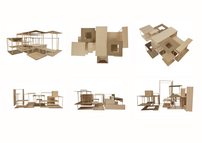
N
FILTER
FilterN creates a myriad of microclimates to emulate the sponteanous nature of climate change and raise awareness of the global crisis. Filters are powerful as they remove certain elemental particles - including rain, snow, ice, sleet, photons (light) - to create spaces that are different from the surrounding environment. By overlapping porous structures, filtration processes of different degrees can be introduced to the intervention that is located on the terrace space next to the planetarium of the American Museum of Natural History in New York City.
In addition to creating a range of microclimates, FilterN also aims to recreate the density that exists in the realm underneath. Pipes - that interlock with porous structures to form the landscape - are extrusions of the sewage, gas, and water pipes that inhabit underground world of Manhattan. Water collected in the pipes are filtered and form part of the larger network that connects the site to other parts of the city to bring the theme of connectivity to the foreground. Larger hollow pipes are used to collect precipitation to create new “ice/water/snow cores” that develop overtime and can be used to create new core samples on site for data processing and research as the years progress.
PERSPECTIVE VIEW

TOP
UNDERGROUND
PLAN IN SITE


EXPLODED AXONOMETRIC

LONGITUDINAL SECTION

SHORT SECTION

N
FILTER IN ACTION - LIGHT
N
FILTER IN ACTION - RAIN
N

























